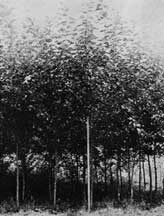New Trees For Our Forests, Page 3
By DOROTHY PARKER ROWE
In western Maine more than 10,000 poplar hybrids planted sixteen years ago bear mute testimony to the importance of hybridization. Every one of these hybrids has different inherent potentialities. Ten years after planting, the best of the new hybrids were from forty to fifty feet tall and from eight to ten inches in diameter, breast height. That represents a diameter growth at the rate of about an inch during a four months' growing season. By conservative estimate, poplar hybrids in Maine grow from two to three times as fast as native poplars. Incidentally, Dr. Schreiner set out the trees the same year his son was born, and when the boy was only ten years old some of the trees were large enough to cut for pulp tests. Remember, this is in northern country where the growing season is very short.
A word about the economic importance of hybrid poplars. Upon testing the wood of these trees, it was found equal to that of native poplars for paper pulp, and there are indications that, for certain chemical uses, the wood of hybrid poplars may be somewhat better.

THESE POPLARS ARE HYBRIDS BRED ON A SPECIAL PROJECT
"Aside from the value of poplar hybrids as rapid wood producers," Dr. Schreiner said, "they serve, in a sense, as guinea pigs. What is learned of inheritance from these trees will be guideposts along the way to improving slower growing forest trees."
Second generation hybrids are even more interesting than first generation hybrids. In contrast to first generation hybrids, which are ordinarily quite uniform and exceptionally vigorous, their progeny usually show a wide diversity of types, often including greater variations in disease resistance.
Although Dr, Schreiner's work has been curtailed for the duration, pedigreed stock obtained from his breeding experiments is being carefully saved. Part of it is growing on the Forest Service area at the Beltsville, Maryland, research center of the Department of Agriculture, and the remainder is at the Morris Arboretum, Philadelphia, where the Allegheny Forest Experiment Station of the Forest Service cooperates with the University of Pennsylvania in forestry research.
Dr. Schreiner foresees a heavy demand for rapid-growing hybrids in the future, what with a large postwar planting program and the new uses being made of veneers and chemical woods, particularly for plastics.
"Not long ago it would have been considered next to impossible to grow trees faster than Nature grows them; yet anyone familiar with what the breeder of agricultural crops has done for the farmer, can visualize the day when hybrid trees may be as common as hybrid corn," Dr. Schreiner predicted.
One thing is certain: the supply of lumber is dwindling fast, and something must be done about it. Faster growing trees will help solve the problem, although, of course, conservation, reforestation and fire protection must be the major factors in meeting our problems of forest resources.
 Printer-friendly version
Printer-friendly version
